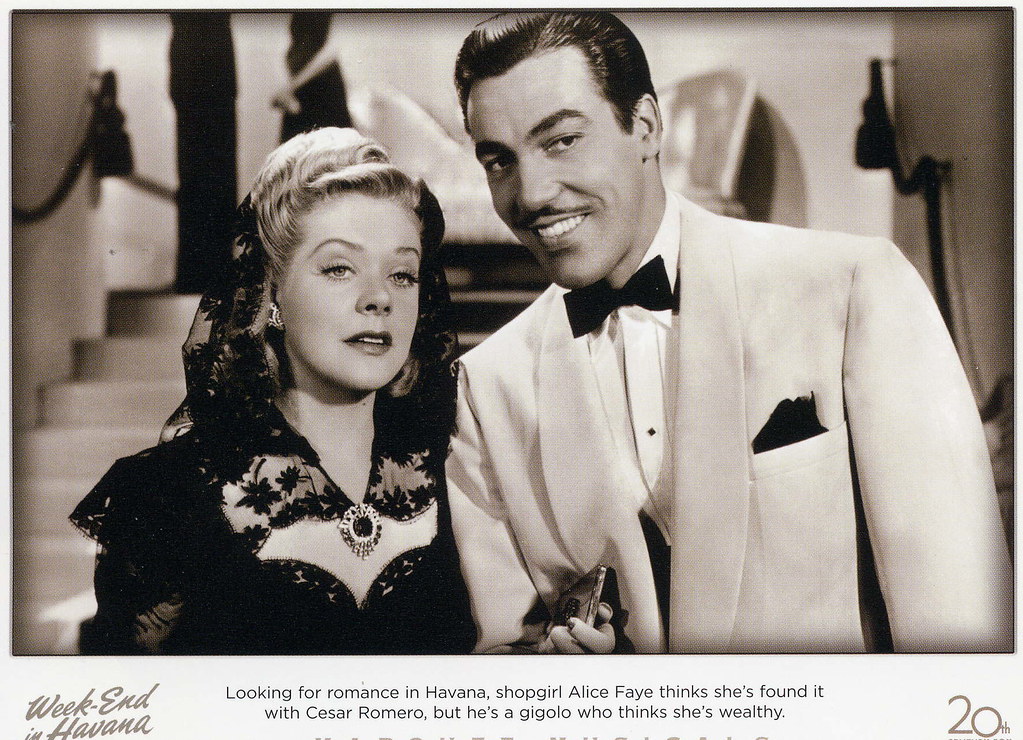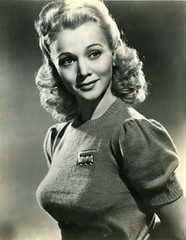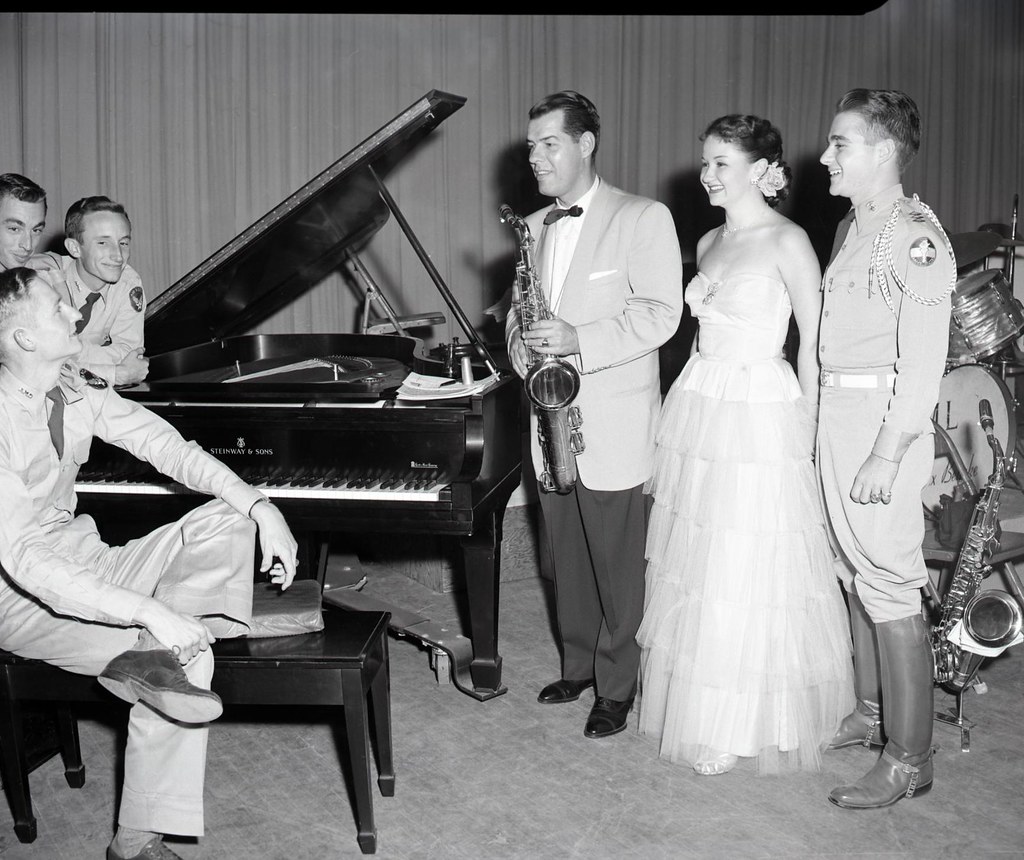
FEATURE image: Glenn Miller Orchestra, 1940-41. Public Domain.
The 1942 music film, Orchestra Wives, from 20th-Century-Fox is one of the best dance band movies ever made. Between 1934 and 1945 Fox studios made 57 musicals and music films (see – https://www.imdb.com/list/ls565533414/.) While M-G-M is known for its musicals where characters sing and dance in place of spoken dialogue, the music film is one that usually features a bandleader – which in Orchestra Wives is Glenn Miller – and musical performers within a band orchestra – Marion Hutton with The Modernaires – as well as music-related acts such as the Nicholas Brothers. In a music film, including Orchestra Wives, characters don’t break out into song but speak in regular speech. In the music film singing and dancing are normally set pieces in a nightclub or on a stage and the music itself is presented in a realistic setting all of which perfectly describes 20th Century-Fox’s Orchestra Wives.

“Ann Rutherford.” by carbonated is licensed under CC BY-NC-SA 2.0.

“George Montgomery – in ”Roxy Hart” 1942” by Movie-Fan is licensed under CC BY-NC-SA 2.0.

The item has no copyright marks as can be seen in the links. At bottom right is a logo indicating the card was produced by a union print shop and Country of origin USA.
· United States Copyright Office page 2 “Visually Perceptible Copies The notice for visually perceptible copies should contain all three elements described below. They should appear together or in close proximity on the copies.
1 The symbol © (letter C in a circle); the word “Copyright”; or the abbreviation “Copr.”
2 The year of first publication. If the work is a derivative work or a compilation incorporating previously published material, the year date of first publication of the derivative work or compilation is sufficient. Examples of derivative works are translations or dramatizations; an example of a compilation is an anthology. The year may be omitted when a pictorial, graphic, or sculptural work, with accompanying textual matter, if any, is reproduced in or on greeting cards, postcards, stationery, jewelry, dolls, toys, or useful articles.
3 The name of the copyright owner, an abbreviation by which the name can be recognized, or a generally known alternative designation of owner.1 Example © 2007 Jane Doe.”
Fox musicals and music films from the mid1930’s to mid1940’s were extremely popular. Orchestra Wives features high production set pieces of original swing music envisioned by its music director Alfred Newman (1900-1970). The film itself was directed by Archie Mayo (1881-1968) whose decades-long career was coming to a close (Mayo retired in 1946, shortly after completing A Night in Casablanca with the Marx Brothers). Orchestra Wives features 38-year-old Glenn Miller (1904-1944) and his 22-piece Band, then at the height of popularity. It was the second of two films Miller made for Fox (the first was Sun Valley Serenade in 1941). The Miller band returned to Hollywood to film 1942’s Orchestra Wives and though contracted to do a third movie for Fox called Blind Date, Miller disbanded the band and entered the US Army. Called the Gene Morrison Band in Orchestra Wives, music includes vocal performances by Marion Hutton (1919-1987) with The Modernaires, tenor sax player Tex Beneke (1914–2000) and Lynn Bari (1919-1989). The film concludes with choreographed athletic tap dancing of the Nicholas Brothers. The film is filled with pop-song classics by the successful writing team of composer Harry Warren (1893-1981) and lyricist Mack Gordon (1904-1959). In Orchestra Wives Warren/Gordon songs included in whole or in part, That’s Sabotage, Chattanooga Choo Choo (a main set piece in Sun Valley Serenade indicating Orchestra Wives picked up right where the previous successful film left off), People Like You and Me, the love ballad At Last, the torch song Serenade in Blue (performed by sultry Lynn Bari) and Orchestra Wives’ main production number (I’ve Got a Gal in) Kalamazoo which was nominated for an Academy Award for Best Original Song (the Oscar went to White Christmas by Irving Berlin). Warren melodies are instantly recognized as simple and fresh and Gordon’s lyrics are free of cliché. The music that opens Orchestra Wives presents the film’s first set piece which is a Warren/ Gordon song, People Like You and Me. It is performed by Glenn Miller and his Orchestra with Marion Hutton and The Modernaires. All of the Warren/Gordon songs for Orchestra Wives were recorded by Glenn Miller – as well as many other musical artists in those years.



“Viudas del jazz” by Kirby York is marked with Public Domain Mark 1.0.
Orchestra Wives is one of the very few films to give insight into the lives of dance band musicians and their singers and spouses on tour. These singers and wives are portrayed in the Hollywood film by glamorous Ann Rutherford (1917-2012), Lynn Bari (1919-1989), Carole Landis (1919-1948), Mary Beth Hughes (1919-1995) and Virginia Gilmore (1916-1986). Each of their glamour and acting ability make dramatic scenes highly entertaining even as they advance the plot by way of bored and distasteful gossiping and rumor mongering.
The three catty spouses in Orchestra Wives are beautiful Carole Landis, Virginia Gilmore and Mary Beth Hughes (below):



PD-US (licensing information : [1]). Public Domain.
Orchestra Wives is a music film with excellent swing music as a highlight and featured in regular intervals that are set on stages such as a record studio, local dance and concert halls, and in nightclubs. The film’s central drama, however, lies in the love relationships of the professional bandmembers and their wives who travel with them. It seems everyone is stressed or bored or both by the intensity of the extra work involved in cross country touring as a musician in a popular swing band. These orchestra wives – namely, Natalie (Carole Landis), Elsie (Virginia Gilmore), and Caroline (Mary Beth Hughes) – are beautiful and jaded about living conditions and unique complications as orchestra wives. When Bill Abbott, the band’s superlative trumpeter, meets Connie Ward (Ann Rutherford), it is on the road at a local dance in Dixon, Illinois. The small-town young woman – daughter of a town doctor (Grant Mitchell) – goes on a date with the local soda jerk just to see and hear Gene Morrison’s swing band. Up close to the stage, it is love at first sight for Connie when handsome trumpet player Bill Abbott (George Montgomery) steps up to perform. The next night, on the spur of the moment, Bill and Connie get married after Connie traveled by bus alone to Elgin, Illinois, for the band’s next gig.

Original studio publicity photo of Ann Rutherford Permission details
This work is in the public domain in the United States because it was published in the United States between 1928 and 1977, inclusive, without a copyright notice. For further explanation, see Commons:Hirtle chart as well as a detailed definition of “publication” for public art. Note that it may still be copyrighted in jurisdictions that do not apply the rule of the shorter term for US works (depending on the date of the author’s death), such as Canada (50 p.m.a.), Mainland China (50 p.m.a., not Hong Kong or Macao), Germany (70 p.m.a.), Mexico (100 p.m.a.), Switzerland (70 p.m.a.), and other countries with individual treaties.

Pre-1978, no mark. Public Domain.
Connie spontaneously joins the life of traveling orchestra wives and is at first innocent of its darker side. Connie learns a lot as she takes the long rides on train tours as a musician’s wife to the band’s engagements around the country and back. Those film scenes reflect accurately the lives of dance musicians of the era who had to take these long tours to far-flung places. Connie is soon at odds with the other wives who come in shapely forms of Natalie, Elsie and Caroline who are bored by the monotony of the road so that their lives get filled with backbiting gossip and being jealous of one another.
Among the many swing era musicals in this period, Orchestra Wives, while a comedy with the usual lighter fare typical for the genre, is notable for its realistic and serious plot. Though called a “musical comedy with the occasional touch of drama” (https://www.quotes.net/movies/orchestra_wives_8473) it is really more of a drama with musical comedy. The naïveté and lack of trust between lovers, namely small-town Illinois girl Connie Ward (played by “America’s sweetheart” Ann Rutherford) and Bill Abbott (played by Western cowboy George Montgomery) — whose fictional bandleader Gene Morrison (played by Glenn Miller) calls him “the best trumpet man in the business” — is raw, serious and real. Sparked by in-house rumor-mongering of band-members’ infidelities as well as other cascading gossip of bored wives on a cross- country band tour, the newlyweds Connie and Bill face their first big crisis as a couple very shortly after they are married. Upon suspecting her husband is having an affair with sultry Jaynie, the band’s lead singer, there is this confrontation between newlyweds whose misunderstanding gets mixed up in embarrassment and resentment:
CONNIE: I know there was nothing wrong between you and Jaynie (played by statuesque Lynn Bari)
BILL: That’s what I told you last night.
CONNIE: But it really wasn’t my fault. It was Natalie (Carole Landis) and Elsie (Virginia Gilmore) and Carole (Mary Beth Hughes) and their gossip started it.
BILL: From what I heard just now, you’ve been spreading a little gossip yourself.

Jaynie, the band’s singer, held a torch for Bill though their affair was over shortly before Bill met Connie and married her. Because Gene Morrison didn’t want to pay for the wives to accompany the band on an overnight gig to Iowa City, the newlyweds were apart for the first time. Natalie gossiped to Connie about other band members’ extra-marital affairs and Carole told Connie about Bill and Jaynie. Connie, apparently unafraid to take the bus alone between towns, travels that way late at night to meet Bill. In the meantime, the gossiping wives call Jaynie (with a reproduction of Whistler’s Mother on the wall behind them) to tell her that Connie is coming to town. After Jaynie and Bill shared an after-show chop suey dinner together, Jaynie propositioned Bill in her hotel room which he declined. Afterwards learning that Connie was coming to the hotel she telephoned Bill’s room and on the pretext of needing cash, Bill comes into Jaynie’s room. Connie discovered the pair together in Jaynie’s room in their pajamas and, as Jaynie planned, is scandalized. Though Bill tells Connie that nothing was going on, Connie storms out, hurt and angry, and gets on the next bus back to Des Moines. The next day, when the band returns, Connie learns that what she was told is gossip. In revenge, Connies spills the beans about spousal infidelities of the gossiping wives that Natalie told her before. Connie’s words result in three band members leaving the tour and to the cancellation of the rest of the tour by bandleader Gene Morrison.
It also leads to a serious dramatic scene between Connie and Bill that honestly explores a situation of any new spouse – not just an “orchestra wife” – who is in love with someone with a stressful job who has to travel and be on the road all the time. The work/home tension is a modern theme and universal to more than a swing band musician’s family. Released in September 1942, Orchestra Wives, was popular cinematic fare in a country that neared its first full year of being “all-in” fighting in World War II. The film has one foot in a carefree pre-war swing era and another in wartime America that brought one of its longest lists of casualties in its history and, soon, the Atomic Age. Orchestra Wives is a music film and ostensible comedy that provides serious treatment to scenes that point, if briefly and thus superficially to the post-war era’s film noir and its themes of jealousy, infidelity, innuendo, mystery, and the femme fatale. To combine music, comedy and serious drama is a highlight of the original screenplay by Karl Tunberg (1907-1992) and Darrel Ware (1906-1944) – a writing team nominated the year before for an Academy Award for screenwriting for Tall, Dark and Handsome also from 20th Century-Fox.
BILL: I married you because you were a happy kid. Gay, cute, cheerful. But you’ve gone neurotic on me. You trail me around like a house detective. And then with one flick of your tongue you bust up our band. Last night you said you weren’t an orchestra wife and you hit the nail right on the head. You aren’t and you never will be.
CONNIE: Maybe you’re right Bill but I’ve tried. I don’t know the two things just don’t seem to go together. Look, how can you be a real wife when you are trailing from one hotel to another like a lot of gypsies? When you have breakfast at lunchtime and lunch at dinnertime and dinner at midnight? Why this isn’t living. Why this isn’t even being married.
BILL: What did you expect – a banker? You married a trumpet player. You weren’t getting a suburban home with flowerpots and kiddies. At the time you seemed to think the idea was pretty glamorous.
CONNIE: Well at the time I was crazy. This life is about as glamorous as a gymnasium.
BILL: Well, I’ll give you a chance for something better. You know that marriage certificate? That little piece of paper with rosebuds on it? Well you can pack it with your things. I’m through with it.
CONNIE: So am I. And I’ll leave you half the pieces.
The climax of the film occurs when Connie walks out on Bill—and vice versa—and leaves their marriage and love hanging in the air. With band members’ tensions among their wives exploding into the open, Gene Morrison (Glenn Miller) has to break up the band. Though these breakups’ flashpoint is Connie and Bill’s open rift, can and will she now help to get the band back together and reconcile with Bill? And who will help her?

Unknown author – Ad on page 80 of Billboard 1944 Music Yearbook
· Public Domain Created: 1 January 1944

About composer Harry Warren and lyricist Mack Gordon.
Orchestra Wives provides a lot of first-class music and a dramatic film record of the dance hall scene in the swing era. (I’ve Got a Gal) in Kalamazoo was nominated for an Academy for Best Original Song. Harry Warren wrote some of the great popular songs of the 1930s and 1940s. Many of them were used in Fox musical films in their heyday. Warren had been writing music in Hollywood since 1932. When he moved from Warner Bros. to Twentieth-Century Fox he was assigned to write for Fox’s well-produced and highly popular musicals.
Harry Warren believed he saw the quality of motion pictures in Hollywood actually improve during World War II, the mid20th century’s major global crisis. Through all of it, Americans, Warren observed, expressed a general feeling of confidence that the war would ultimately be won. This excitement translated to the movies at the time.
In addition to working with lyricist Mack Gordon (1904-1959), Warren worked with Fox’s arranger-orchestrator Herbert Spencer (1905-1992). In a long career, Spencer worked with many successful composers and helped orchestrate scores in Holiday Inn (1942), Gentleman Prefer Blondes (1953), Call Me Madam (1953), Carousel (1956), Funny Girl (1968), Hello, Dolly (1969), and more, but he expressed especial enjoyment working with Warren.
Warren’s many inspired melodies, Spencer thought, were simple but logical, seemingly inevitable, and Warren’s song drafts arrived to Spencer filled with detail that helped make the orchestrator’s role more interactive. Spencer also enjoyed working personally with Warren whom the Chilean-born arranger described as “simpatico.” Warren, unlike other busy composers, was accessible to discuss and develop a musical score. With beguiling modulation, the songs rise and fall in intervals, and its notes and meter, as Herbert Spencer might have had it, follow their logical and effortless path.
Head of production at 20th Century-Fox and producer of Orchestra Wives, William LeBaron was brought to Hollywood by Joseph P. Kennedy.

While not in the top ten films of 1942 that earned between $2.885 (M-G-M’s Somewhere I’ll Find You starring Clark Gable and Lana Turner) and $5.358 million (M-G-M’s Mrs. Miniver starring Greer Garson and Walter Pidgeon), 20th Century-Fox’s Orchestra Wives produced a solid and popular music film that took in a very respectable $1.3 million at the box office.
SOURCES:
The Films of 20th Century-Fox A Pictorial History, Tony Thomas and Aubrey Solomon, Secaucus NJ: Citadel Press, 1985, pp. 129-130.
The Dance Bands, Brian Rust, New Rochelle, NY: Arlington House Publishers, 1974, pp. 140-142.
Harry Warren and the Hollywood Musical, Tony Thomas, Foreward by Bing Crosby, Secaucus NJ: Citadel Press, 1975, pp. 184-189.







